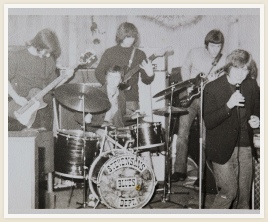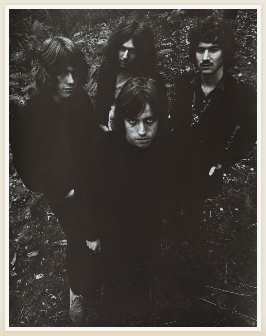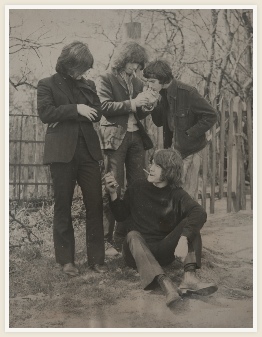






Before Iron Maiden, the stadium band, there was the (Original) Iron Maiden . They formed in 1968 in Basildon, Essex, in what was at the time, a blues boom, heralded by John Mayall and the Bluesbreakers.
However, even before this Maiden was formed two band members, Steve Drewett (vocal / harmonica) and Barry Skeels(vocal / guitar / slide guitar) formed a blues duo called Stevenson's Blues Dept. They supported acts like Peter Green’s Fleetwood Mac, Blodwyn Pig, King Crimson, Idle Race and Jethro Tull at venues in London and Essex. Steve & Barry became friends with Peter Green’s Fleetwood Mac playing as support whenever they were in the area.
Finding a duo limiting they decided to form a band, with Barry Skeels, moving on to play bass and found two other Essex musicians, Graham (Gruff) Esgrove (guitar) and Paul Reynolds (drums). They wanted to find a band name that both, shocked and would be remembered, they came up with BUM (and if anyone asked, it was a slang term for an American tramp). Unfortunately this caused problems with promoters, billing and advertising etc. but it had it’s desired effect with many mentions in Melody Maker, NME, IT and other music magazines of the day. Finally getting over this hurdle, the name started to became acceptable and went onto support acts like Rory Gallagher & Killing Floor at venues such as The Haverstock Hill Country Club - Belsize Park, Blue Horizon - Wandsworth, Roundhouse - Dagenham, Chelmsford Corn Exchange, The Marquee in Wardour Street & Bottleneck Blues Club - Stratford
They also gained a manager, Len Green brother of Peter Green of Fleetwood Mac, for a brief period. The band finally made it into a studio in Southend and demoed two self penned blues tracks Help & Ramblers Blues
In early 1969, Gruff left the band and they recruited Trevor Thoms on guitar, who answered an advert placed in the Melody Maker. They continued to gig and write their own material which now under the influence of Trevor's writing and input started to lose the blues feel and become a more darker gothic style progessive rock band airing on 23 Aug, 1969, at a festival in Grays, Essex supporting The Who & Amen Corner.
A little later, the band met Stan Blackbourn, who had previously worked for the Rolling Stones and Immediate Records and who also just happened to live in Basildon. At this time Stan worked for President Records (Eddie Grant and the Equals label) and after seeing the band play live, took over as their manager. President Records were starting a new rock label called Gemini Records and through Stan’s connection were keen to sign the band. But again the sticking point was the band’s name. And so after much deliberation they came up with the name IRON MAIDEN, which sounded more appropriate for the band’s new direction anyway.
With a concentration on new, dark songs, the setlist had changed out of all recognition from those early days and on Friday, Jan 30th 1970, they performed this new material starting with a midnight gig at 'The Temple', Wardour Street, which was the old Flamingo Club, supporting The Egg, Formerly Fat Harry & Gary Farr and later that year David Bowie.
Gemini provided them with the opportunity to record some of songs as demos for their debut album at Regent B, Denmark Street, where the Rolling Stones recorded in their early days, later used by Mott the Hoople . These were Plague, Liar , Ritual, CC Rider (a jam of an old Blues favourite of the band), God of Darkness and The Ballad of Martha Kent. Also at this time Stan was working on the possibility of getting the band a 3 month tour in Australia.
Now with the new name of Iron Maiden, it was at this point that Paul Reynolds decided to leave the band, he was unable to go to Australia due to work commitments. Paul's last gig with the band was supporting David Bowie & Hype at the Basildon Arts Centre, Feb 28th 1970,. The band placed an advert in the Melody Maker and Paul was replaced by Steve Chapman, ex Junior’s Eyes (later joining USA band Poco).
It was then they went into the studio to record the single Falling / Ned Kelly, to coincide with the Australian tour and Mick Jagger's film Ned Kelly. Due to an argument between the UK's Musicians Union & Australia’s PRS all UK bands were banned from going to Australia until royalty rates, between the two countries, were sorted out. This setback led to Steve Chapman leaving the band and because Gemini had still not come up with the recording time for their debut album, the band lost faith in the whole project. By the mid 1970s this Iron Maiden was no more.
In 1998 a company called Audio Archives, rediscovered the band and put together a CD made up of the tracks from a cassette tape of the Denmark Street recordings and a copy of the only single to be released supplied by Barry Skeels.
Recently in 2012, Rise Above Records remastered the original Denmark Street tracks from reel to reel tapes (found in his loft by Steve Drewett), as well as the single, and as a bonus, the earlier BUM tracks they released them on CD and vinyl. Rise Above have also produced the sleeve design artwork idea that would of been used on the original album, had Gemini moved forward with it, and used the original album title ‘MAIDEN VOYAGE’ together with an in depth booklet of rare photos, memorabilia & press cuttings. As there is now a major stadium band called IRON MAIDEN, they have called this band The (Original) Iron Maiden. Some music press have reported this earlier Maiden as ‘the original doom metal band’
Since those days Barry Skeels & Paul Reynolds are still continuing to play in live bands. Steve Drewett moved into special effects for TV & film and as a film director. Steve Chapman joined USA band Poco between 1978 / 1987.
After many years playing with ex Hawkwind members, Trevor Thoms sadly died on 8th Dec 2010.


